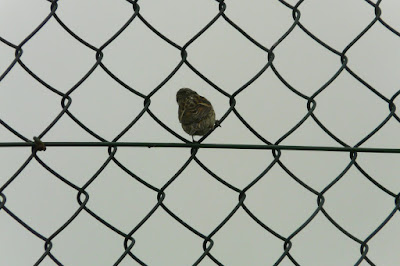It is one of the smaller members of the Finch family. At about 12cm. (Chaffinch is about 15cm, House Sparrow 14cm) I just hope that it's visit won't be a one-off this year, as it was in 2008.
The Willow Warbler(s?) are visiting the Fennel now and then for Insects, but always whenever I'm too late for getting the camera.
Lesser Redpoll, Carduelis cabaret.
 The two buff curved wingbars and its size were enough to me to ID it, this time. The lack of red forecrown means that it should be a juvenile. So, are the parents nearby? Another birder in Limerick in the West of Ireland, had been surprised at hearing that I had no Lesser Redpolls untill that one bird in 2008. He had large flocks of them.
The two buff curved wingbars and its size were enough to me to ID it, this time. The lack of red forecrown means that it should be a juvenile. So, are the parents nearby? Another birder in Limerick in the West of Ireland, had been surprised at hearing that I had no Lesser Redpolls untill that one bird in 2008. He had large flocks of them.
Used to have up to 12 male Chaffinches. This spring my highest number was 4. Very sad. Similarly, only one to three females at most.
male Chaffinch, Fringilla coelebs.

The House Sparrows too are less this year. I'll post more pictures tomorrow.
House Sparrow, Passer domesticus. Juvenile.

Here, the trembling spread out wings on this Juvenile House Sparrow, is how it will indicate to the parents that it is hungry. Whenever you see an adult female perform a similar action to a male of the same species, it is her way of telling him that she is ready to mate.

Starling do live in the Hawthorn, yet I am blessed that they never get into the garden to feed. Sometimes a few do come into the front or back, but more out of curiosity than following the other birds to the food. Usually they 'greet' me with their quirky song early morning when I come outside to put food out. They fly about the extensive area of our village, and also feed in the bay sometimes. Yet, catching three youngsters, yesterday morning, I had to get a few shots. They look so different from their black starred parents.
Juvenile Starling, Stumus vulgaris.



No comments:
Post a Comment
Thank you for visiting Birding on Wheels; All comments left here, will be appreciated and I will answer as soon as possible to your comments.
Yoke.